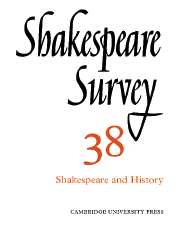Book contents
- Frontmatter
- Shakespeare’s History Plays: 1952–1983
- Shakespeare and History: Divergencies and Agreements
- Shakespeare’s Georgic Histories
- The Nature of Topicality in Love’s Labour’s Lost
- The Tragic Substructure of the Henry IV Plays
- Hal and the Regent
- The Rite of Violence in I Henry IV
- The Fortunes of Oldcastle
- Hand D in Sir Thomas More: An Essay in Misinterpretation
- Livy, Machiavelli, and Shakespeare’s Coriolanus
- Henry VIII and the Ideal England
- The Strangeness of a Dramatic Style: Rumour in Henry VIII
- ‘Edgar I Nothing Am’: Figurenposition in King Lear
- ‘Very like a whale’: Scepticism and Seeing in The Tempest
- Shakespeare’s Medical Imagination
- Shakespeare in the Theatrical Criticism of Henry Morley
- Shakespeare Performances in Stratford-upon-Avon and London 1983–4
- The Year's Contributions to Shakespearian Study 1 Critical Studies
- 2 Shakespeare’s Life, Times and Stage
- 3 Editions and Textual Studies
- Index
Henry VIII and the Ideal England
Published online by Cambridge University Press: 28 March 2007
- Frontmatter
- Shakespeare’s History Plays: 1952–1983
- Shakespeare and History: Divergencies and Agreements
- Shakespeare’s Georgic Histories
- The Nature of Topicality in Love’s Labour’s Lost
- The Tragic Substructure of the Henry IV Plays
- Hal and the Regent
- The Rite of Violence in I Henry IV
- The Fortunes of Oldcastle
- Hand D in Sir Thomas More: An Essay in Misinterpretation
- Livy, Machiavelli, and Shakespeare’s Coriolanus
- Henry VIII and the Ideal England
- The Strangeness of a Dramatic Style: Rumour in Henry VIII
- ‘Edgar I Nothing Am’: Figurenposition in King Lear
- ‘Very like a whale’: Scepticism and Seeing in The Tempest
- Shakespeare’s Medical Imagination
- Shakespeare in the Theatrical Criticism of Henry Morley
- Shakespeare Performances in Stratford-upon-Avon and London 1983–4
- The Year's Contributions to Shakespearian Study 1 Critical Studies
- 2 Shakespeare’s Life, Times and Stage
- 3 Editions and Textual Studies
- Index
Summary
At the end of Henry VIII Cranmer delivers a prophecy of the golden age of Queen Elizabeth, in a speech that seems designed both as the last in a series of striking set-pieces and as the culmination of the play’s action. The elaborate and sometimes devious historical process the play has shown has been designed, we now realize, to allow Elizabeth to be born and to make this golden age possible. For the characters in the play, however, the age of Elizabeth lies in the future and, we are told, ‘Few now living can behold that goodness’ (5.4.22). For the audience it lies in the past. Like all golden ages it is just the other side of the horizon. If the author had been content to leave it there we might have been content to accept the convention. But Cranmer extends his idealizing vision to the present, to the reign of James; this too is part of the golden age. At this point the more realistic spectators might have reflected on the difference between dream and reality, and concluded that nothing gold can stay. The same train of thought might have prompted memories of the dark, unsettled end of Elizabeth’s reign, memories against which Cranmer’s vision could be tested. Cranmer is not just taking his audience somewhere over the rainbow; he is also asking it to see its own present, and its own immediate past, as a golden age. Outside the special conditions of court masque and complimentary verse, that takes some doing. And it was not what Jacobean drama normally did.
- Type
- Chapter
- Information
- Shakespeare Survey , pp. 131 - 144Publisher: Cambridge University PressPrint publication year: 1986

